Introduction
Effective product authentication has become critical for luxury brands as counterfeit goods now account for over 60% of global seizures in the luxury sector. The counterfeit market is growing at an alarming rate of 22% annually, with luxury brands losing approximately 10% of their sales each year to fake products. According to the Global Brand Counterfeiting Report, this illicit market reached 1.2 trillion USD in 2017 and was projected to grow to over 1.8 trillion USD by 2020.
Beyond financial losses, counterfeiting has devastating human consequences as well. In G20 member countries alone, an estimated 3,000 deaths occur annually due to counterfeit consumer goods. Additionally, these countries lose USD 77.5 billion in tax revenues while incurring an extra USD 25 billion in crime-related costs. Therefore, we must address this growing threat with robust brand authentication solutions that can effectively protect both businesses and consumers.
In this blog, we’ll explore how the Global Data Synchronization Network (GDSN) provides powerful product authentication technology to combat counterfeiting in luxury supply chains. We’ll examine how GDSN enables real-time data sharing, integrates with modern verification systems, and helps brands implement effective product authentication checks throughout their distribution networks.
Key Takeaways
- Counterfeiting costs luxury brands 10% of annual sales, with the global counterfeit market reaching $1.8 trillion by 2020 and causing over 3,000 deaths annually from unsafe fake products.
- GDSN creates unbreakable product authentication through unique GTIN and GLN identifiers that enable real-time data sharing across global supply chains with 44 certified data pools worldwide.
- Integration with modern technologies amplifies protection: Digital QR codes, blockchain records, and AI-powered verification systems work together with GDSN to create a multi-layered defense against sophisticated counterfeiters.
- Real-world success spans luxury sectors from fashion houses using RFID serialization to leather producers implementing DNA tracers, with pharmaceutical studies showing 100% effectiveness in identifying counterfeits.
- GDSN ensures regulatory compliance while enhancing consumer engagement, helping brands meet EU Digital Product Passport requirements, and enabling direct consumer authentication through connected platforms.
Understanding the Counterfeit Threat in Luxury Supply Chains
The luxury sector faces an unprecedented challenge as counterfeiters continuously refine their techniques. Today’s fake products have evolved beyond obvious knockoffs into sophisticated replicas that can deceive even experienced buyers. This growing sophistication fundamentally threatens the foundations of luxury brand value.
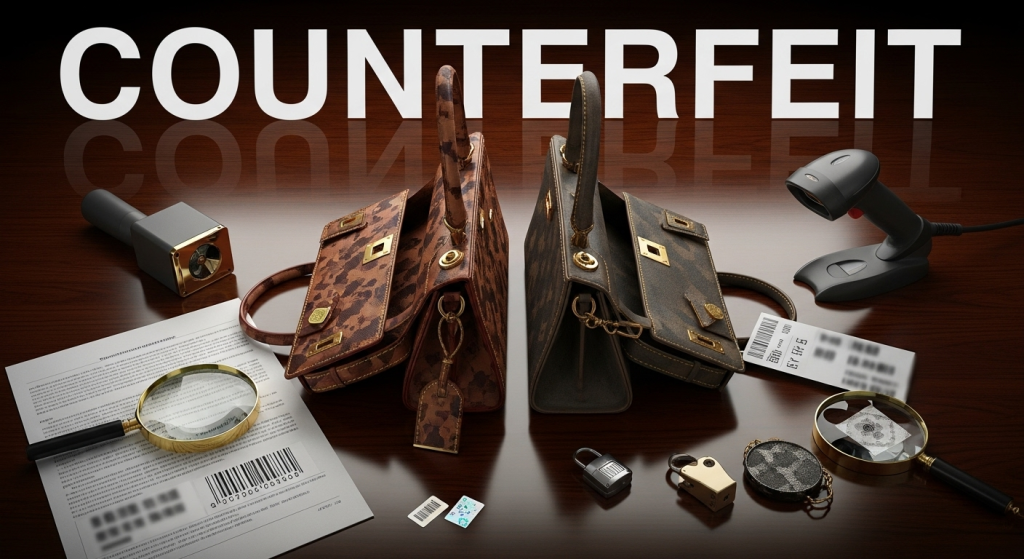
Impact of Counterfeiting on Brand Equity and Consumer Trust
The financial toll of counterfeiting on luxury brands extends far beyond direct revenue losses. Specifically, counterfeit-related revenue losses resulted in over 260,000 job cuts globally in 2023 alone. Furthermore, these financial impacts undermine the exclusivity and prestige that luxury brands work diligently to establish, essentially diluting their carefully cultivated brand image.
Consumer trust, perhaps a luxury brand’s most valuable asset, becomes severely compromised when authenticity comes into question. As one industry expert noted, “Once someone managed to get a fake through the door, and you ended up sending that to an end customer that spent their hard-earned money… there’s a huge chance that you’re missing that customer for life”. This erosion of confidence extends beyond individual purchases to affect entire brand perceptions, particularly as social media transforms counterfeiting into a viral spectacle where influencers showcase “super fakes” to millions of viewers.
Notably, the counterfeit supply chain creates severe environmental consequences, with 36.2% of counterfeit goods tested containing hazardous toxins that contaminate ecosystems. Moreover, ethical violations throughout these supply chains—including forced labor, child labor, and unsafe working conditions—compound the social damage.
Why Traditional Authentication Methods Fall Short
Conventional authentication approaches have not kept pace with increasingly sophisticated counterfeiting techniques. Paper certificates, holograms, and serial numbers—once considered reliable identifiers—now prove inadequate against tech-savvy counterfeiters. Although both consumers and experts are familiar with manual inspection methods and serial number verification, knowledge about more advanced authentication methods remains unevenly distributed.
Research highlights a significant discrepancy: experts display higher knowledge of authentication methods than consumers, whose actual knowledge might be even lower than survey results suggest. Half of the experts surveyed reported finding implementation of thorough identification methods rather difficult, compared to only 2% of consumers who recognized this challenge. Meanwhile, both groups expressed concerns about the reliability of existing methods, with three out of eight experts and 46% of consumers noting a lack of trust in current verification approaches.
Consumer preferences add another dimension to this challenge. Although consumers desire many additional features for product authentication that experts consider less important—such as certificates, fast verification, and uniform procedures—both groups agree on the potential of digital methods. Interestingly, consumers rated blockchain-based product identification and ownership transfer significantly higher than experts did.
The fundamental problem remains: counterfeiters strategically target high-demand items using data intelligence to track best-sellers. As counterfeit quality continues to improve, traditional authentication methods become increasingly inadequate for securing brand integrity in luxury supply chains.
What is GDSN and How It Supports Product Authentication
Ensuring authentic products requires a robust technological infrastructure. The Global Data Synchronization Network (GDSN) has emerged as a powerful tool in the fight against counterfeiting, especially for luxury brands seeking to protect their market position and consumer trust.
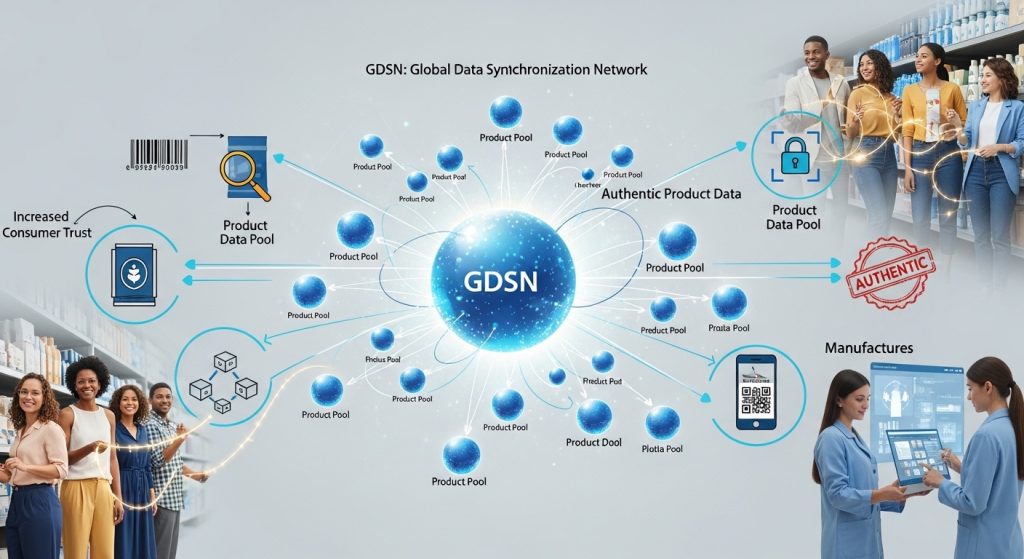
Global Data Synchronization Network (GDSN) Overview
The GDSN is an internet-based, interconnected network of interoperable data pools governed by GS1 standards. This sophisticated system was meticulously designed to solve the complex challenge of sharing accurate product information among trading partners across global supply chains. At its core, GDSN operates using a publish-subscribe pattern between trading partners, each registered with and accessing the network via a data pool.
The network’s primary function is to enable companies worldwide to exchange standardized product master data with their trading partners. Through this process, high-quality product content is uploaded, maintained, and shared automatically, ensuring all parties have immediate access to the most current and complete information. This standardization creates a solid foundation for product authentication checks by establishing a single source of truth for product specifications.
Currently, there are 44 GDSN-certified data pools. Commport GDSN Datapool, a GS1-certified GDSN Datapool since 2005, trusted by over 3,000 brands globally, enables companies to centralize, enrich, and synchronize product data in real-time with any trading partner worldwide.
Role of GTIN and GLN in Unique Product Identification
The backbone of effective product authentication within GDSN lies in two critical product identifiers: the Global Trade Item Number (GTIN) and Global Location Number (GLN).
The GTIN serves as a unique 14-digit identification number assigned to trade items. Brand owners assign GTINs to each level of their product packaging hierarchy (e.g., each inner, case, pallet). Consequently, this identifier functions as a key to retrieving predefined information about products, including prices and product attributes.
Equally important, the GLN uniquely identifies legal entities, trading partners, and locations within the supply chain. Companies must assign GLNs for each of their legal entities, functional entities, and physical locations. The combination of GTIN and GLN establishes a robust authentication framework, enabling the precise tracking of products throughout the supply chain.
Together, these standardized identifiers support the Electronic Product Code (EPC) used in Radio Frequency Identification (RFID), providing information about a product’s exact location in the system. For luxury brands, this means having the tools to verify product authenticity at any point in the distribution chain.
How GDSN Enables Real-Time Data Sharing Across Partners
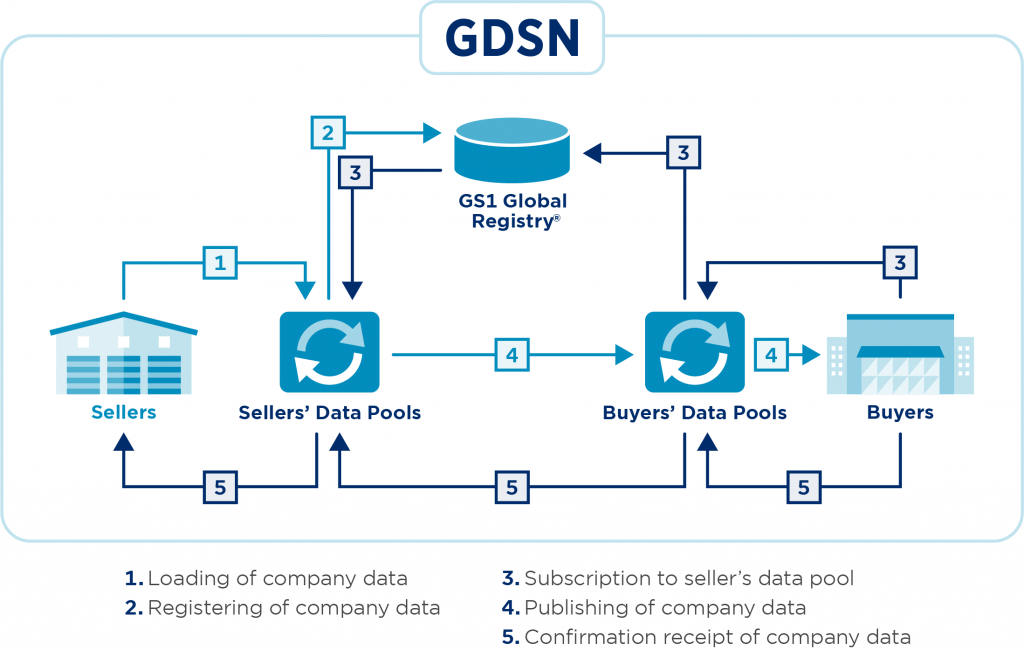
GDSN’s real-time data sharing capabilities transform product authentication from a periodic check to a continuous verification process. The system operates through a structured workflow:
- Loading of company data – Brand owners upload their product information to their selected data pool
- Registration of company data – The data pool registers this information with the GS1 Global Registry
- Subscription – Trading partners subscribe to receive specific product data
- Publishing – The data is published to interested trading partners
- Confirmation – Receipt of company data is confirmed
This continuous synchronization ensures that whenever a supplier updates data in their pool, the change is immediately reflected in all trading partners’ systems. For luxury brands, this means authentication checks can verify against the most current product specifications in real-time.
The GDSN validates data using GTIN Management Rules, assuring proper use of GS1 identification numbers. This validation process serves as an additional layer of security for brand authentication solutions by ensuring data integrity.
Unlike traditional authentication methods, GDSN isn’t a one-time effort but a continuous, integral part of the overall supply chain process. This ongoing verification creates a dynamic defense against sophisticated counterfeiters who might otherwise exploit outdated authentication parameters.
For luxury brands implementing product authentication technology, GDSN provides the infrastructure to maintain consistent, accurate product information globally, ensuring authentication checks performed anywhere in the world reference the same verified specifications.
Integrating GDSN with Product Authentication Technologies
Modern luxury brands require multi-layered authentication systems working in concert. GDSN provides the crucial data foundation upon which cutting-edge authentication technologies can operate with maximum effectiveness.
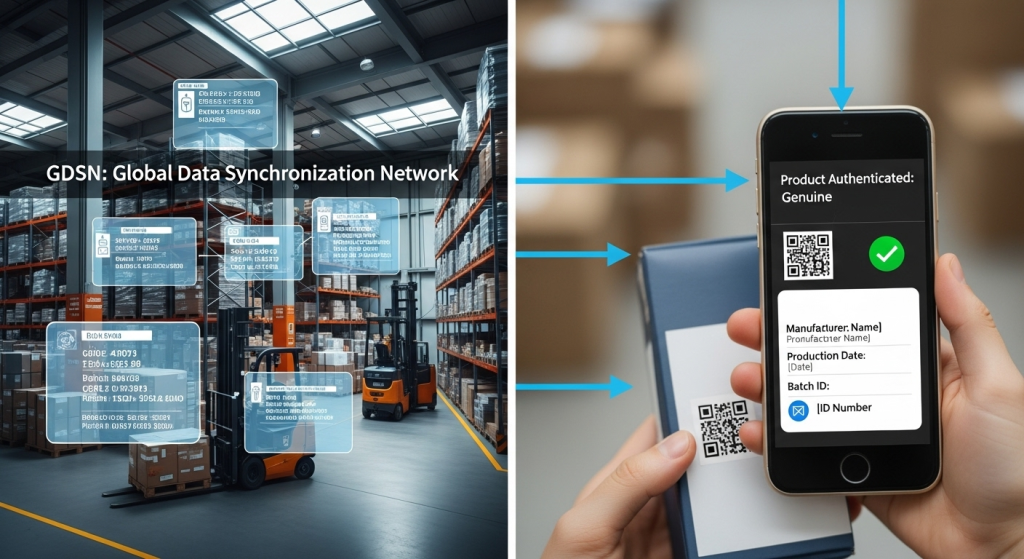
Linking GDSN with QR Codes and NFC Tags
QR codes have evolved significantly—digital link QR codes represent a substantial advancement in product authentication technology. Built on the GS1 digital link standard, these next-generation codes unlock dynamic, structured streams of digital information rather than pointing to a single static page. This creates a robust bridge between physical products and digital verification systems.
What makes digital link QR codes powerful for luxury brand authentication:
- They support multiple carrier formats (QR codes, Data Matrix codes, NFC tags) while delivering comprehensive product information in real time
- They enable full product traceability throughout the supply chain
- They create a digital handshake between businesses, systems, and consumers
When connected to GDSN, these codes gain access to continuously updated, standardized product data, ensuring authentication checks reference the most current specifications.
Blockchain Integration for Immutable Product Records
Blockchain technology creates permanent, tamper-resistant records of product data—a perfect complement to GDSN’s standardized information architecture. By anchoring GDSN product data to blockchain networks, luxury brands establish an unalterable history of each authentic item from production through distribution.
For the luxury sector authentication, blockchain integration addresses a critical need: maintaining data integrity throughout the authentication process. Once product data from GDSN is recorded on the blockchain, it becomes virtually impossible to alter without detection—creating a trusted verification backbone.
Commport GDSN Datapool, a GS1-certified GDSN Datapool since 2005, trusted by over 3,000 brands globally, enables companies to centralize, enrich, and synchronize product data in real-time with any trading partner worldwide, providing the essential foundation for blockchain-based authentication systems.
Using GDSN to Power AI-Based Product Authentication Checks
AI-powered solutions now enhance authentication capabilities by analyzing product data against established parameters. Built with advanced AI capabilities and synchronized with GS1 standards, these systems enable brands and manufacturers to make their products more secure.
First, AI systems can continuously analyze GDSN data patterns to establish authentication baselines for legitimate products. Subsequently, when an item requires verification, AI compares its characteristics against these established parameters, flagging potential counterfeits with greater accuracy than manual inspection.
In addition, AI can detect subtle anomalies in product attributes that might indicate tampering or counterfeiting. For instance, the growing implementation of GDSN in healthcare demonstrates how critical authenticated product data becomes when consumer safety is at stake.
Through these technological integrations, GDSN transforms from a data synchronization network into an active defense against sophisticated counterfeiting operations targeting luxury brands.
GDSN in Action: Real-World Use Cases from the Luxury Sector
Real-world applications demonstrate GDSN’s effectiveness in combating counterfeits across the luxury sector. From fashion houses to pharmaceutical companies, organizations increasingly implement standardized data systems to protect brand integrity and consumer trust.
Use Case 1 - Serialization and Authentication in High-End Fashion
Across the luxury fashion industry, serialization has become the cornerstone of counterfeit protection. Every serialized product receives a unique identifier that functions like an identity card, remaining linked to the item throughout its existence. This approach makes each product an original that cannot be duplicated. Fashion brands have found that combining global article numbers (GTIN) with serial numbers creates a powerful authentication mechanism that counterfeiters struggle to replicate.
Radio frequency technology (EPC/RFID) provides additional protection by securing products both during transit and at point-of-sale locations. Indeed, this dual-layer approach ensures product authentication at multiple touchpoints. Forward-thinking luxury brands now embed unclonable NFC chips directly into products during manufacturing, creating physically distinct items that can be verified instantly via smartphone.
Use Case 2 - GDSN-Enabled Traceability in Leather and Jewelry Products
Beyond fashion, the leather industry has embraced traceability systems that track every commercial transaction throughout the supply chain. This process accounts for the time and place of each step in production, obviously enhancing authentication capabilities. The Leather Industry Association (LIA) specifically recommends systems that allow individual hide identification and traceability using in-product tracers linked to robust data systems.
Some leather producers implement DNA molecule tracers from providers’ technologies that withstand intensive processing stages. Others utilize on-product tracers, including GS1 barcodes, physical stamping, and laser marking. These identification methods create transparency that reduces environmental and social risks while enhancing credible communication with stakeholders.
Ensuring Compliance and Consumer Engagement with GDSN
Regulatory compliance and consumer engagement have become critical priorities for luxury brands, protecting their products in global markets. As verification standards evolve, GDSN offers comprehensive tools to meet regulatory requirements while simultaneously enhancing consumer trust.
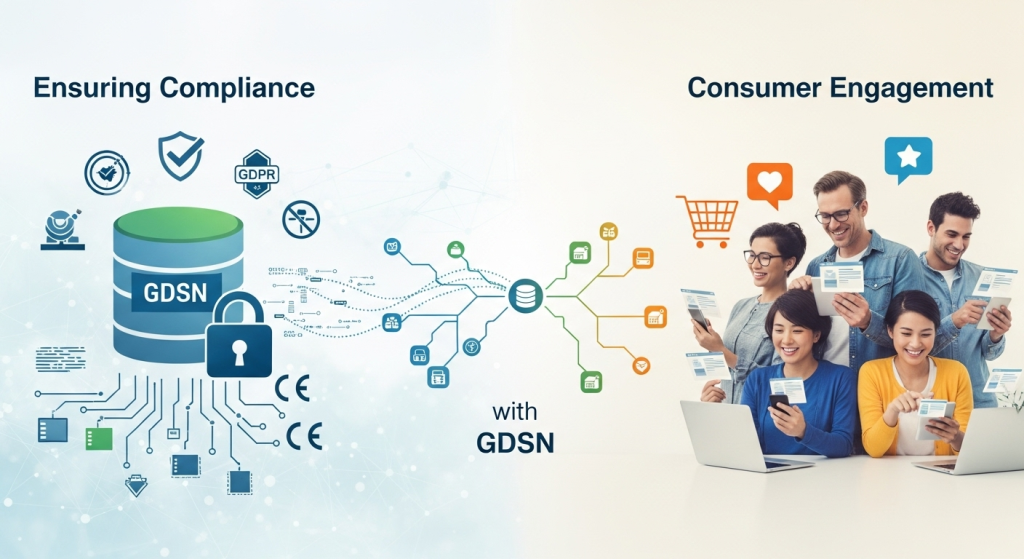
1. Meeting EU Digital Product Passport Requirements
Starting in 2024, the European Union will implement new regulations requiring nearly all products sold in the EU to feature a Digital Product Passport (DPP). This initiative, part of the Ecodesign for Sustainable Products Regulation, aims to enhance transparency across product value chains by providing comprehensive information about each product’s origin, materials, environmental impact, and disposal recommendations.
The DPP will include:
- Unique product identifiers
- Compliance documentation
- Information on substances of concern
- User manuals and safety instructions
- Product disposal guidance
For luxury brands, GDSN provides the ideal infrastructure to meet these requirements through standardized product data that can be automatically shared across the supply chain.
2. Enhancing Brand Authentication Solutions with GDSN
GDSN strengthens brand authentication by creating a universal language between retailers, distributors, and trading partners. When suppliers update product data, the changes are instantly available to all trading partners and all consumer touchpoints. This real-time synchronization is invaluable for product authentication checks.
Commport GDSN Datapool, a GS1 Certified GDSN Datapool since 2005, trusted by 3000+ brands globally, enables companies to centralize, enric,h and synchronize their product data in real time to any trading partner in the world.
3. Consumer-Facing Authentication via GDSN-Linked Platforms
Forward-thinking luxury brands are connecting GDSN data with consumer-facing interfaces. Technologies like QR codes and NFC tags linked to GDSN data allow consumers to verify authenticity directly. These connected product solutions transform traditional items into interactive platforms that offer enriched experiences beyond the physical product.
The combination of GDSN with tamper-proof seals creates powerful verification tools. When the packaging is opened, electronic tags detect this change and update the product signature, which can be verified through authentication platforms. This creates a robust system where consumers can confirm product authenticity with confidence.
Conclusion
The counterfeit market presents an escalating threat to luxury brands worldwide, with financial losses reaching billions annually and significant human costs through unsafe products. Accordingly, robust authentication solutions have become essential for protecting brand integrity and consumer trust. GDSN stands out as a powerful defense mechanism against sophisticated counterfeiting operations, providing a standardized data infrastructure that supports real-time verification across global supply chains.
Throughout this article, we explored how GDSN works through unique identifiers like GTIN and GLN to establish unassailable product authentication. The system excels particularly when combined with cutting-edge technologies – digital link QR codes offer dynamic verification capabilities, blockchain integration creates immutable product records, while AI-powered systems detect subtle anomalies that might indicate tampering or counterfeiting.
Real-world applications demonstrate GDSN’s effectiveness across luxury sectors. Fashion houses implement serialization with RFID technology, leather producers utilize traceability systems with molecular tracers, and even pharmaceutical companies adopt GS1 standards to protect their products. These implementations prove that standardized data synchronization offers a formidable shield against counterfeiters.
Beyond protection, GDSN helps luxury brands prepare for upcoming regulatory requirements such as the EU Digital Product Passport while simultaneously enhancing consumer engagement. Consumer-facing authentication platforms linked to GDSN data empower customers to verify product authenticity directly, thus rebuilding trust in an era where sophisticated counterfeits threaten brand value.
The fight against counterfeiting demands multi-layered defense systems. GDSN provides the foundation upon which modern authentication technologies can operate with maximum effectiveness. As counterfeiters continue to refine their techniques, luxury brands must adopt comprehensive data synchronization strategies to safeguard their products, protect consumers, and preserve their hard-earned reputation for excellence.
Commport GDSN Datapool - GS1 Certified Datapool Since 2005
Download: GDSN Buyers Guide
Empower your business with global data synchronization; download our GDSN Buyer's Guide today and take the first step towards streamlined, accurate, and compliant product data management.
Frequently Asked Questions
Luxury brands employ multi-layered strategies, including the use of Global Data Synchronization Network (GDSN) for real-time product authentication, unique identifiers like GTINs and GLNs, and integration with technologies such as digital QR codes, blockchain, and AI-powered verification systems.
Many luxury brands now offer consumer-facing authentication platforms linked to GDSN data. These often utilize technologies like QR codes or NFC tags, allowing consumers to directly verify product authenticity using their smartphones, enhancing trust and engagement.
Counterfeiting causes significant financial losses, with luxury brands losing approximately 10% of their annual sales. It also damages brand reputation, dilutes brand image, erodes consumer trust, and can lead to job losses in the industry.
Advanced technologies like RFID serialization, DNA molecular tracers, and GS1-standard data matrices are proving highly effective in combating counterfeits. For instance, in the pharmaceutical industry, these technologies have shown 100% effectiveness in identifying counterfeit, recalled, and expired products.





